I took 9 women’s swimming wetsuits and tested them out over a cold British winter with my team of friends and fellow cold water swimming experts. Here’s all the valuable info I found from our comprehensive testing.

From a bit of extra warmth to help with your technique, swimming wetsuits have a few different functions. Choosing one that’s the right thickness and has the features you need can be confusing. And, even if you know what you’re looking for, the choice is baffling.
My swimming wetsuit test looks at three elements: 1/ fit and size range, 2/ insulation and 3/ function and features. For more help choosing the right swimming wetsuit, scroll down for my Buying Guide. If you’re plus-size (size UK 16/18+), read my guide to plus-size swimming wetsuits.
The good news is that there is more choice in swimming wetsuits than ever before – and that means better sizes and price points. Here are some of my favourites.
At a glance
Best all-round performance wetsuit for outdoor swimmers – HUUB Araya
Best all-round swimming wetsuit – One piece Openwater Vitalis TRN wetsuit
Best triathlon wetsuit – Orca Athlex Float
Best breaststroke wetsuit – Finisterre Yulex shorty
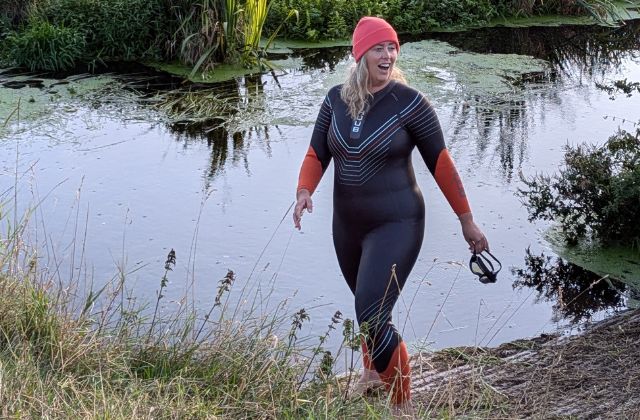
1/ HUUB Araya women’s swimming Wetsuit
Best all-round performance wetsuit for outdoor swimmers
Specifications
- Reasonable price point
- Arms Neutral positioning

- High grade neoprene
- Nylon faced neoprene cuffs
- Upper body freedom and lower body lift
- Exclusive 2:4 buoyancy profile
- Smoothskin coating
Reasons to buy: Comfortable, flexible, inclusive sizing for taller or shorter swimmers
Reasons to avoid: Unwanted leg lift in women’s wetsuits
As an endurance swimmer, this is my go-to wetsuit. I have swum miles in it for hours at a time in water from 14-18˚C (57-61˚F).
HUUB is renowned for its high-performing open-water swimming kit. The Araya is its most popular suit.
It’s neoprene feels incredibly soft for a fantastic fit. But it was the shoulder flexibility that most impresses me. Using what HUUB calls ‘Arms Neutral positioning ’, it gives real freedom of movement over a long period of time.
’, it gives real freedom of movement over a long period of time.
I also love that HUUB offers tall-curvy and short-curvy sizing for women, and short-wide size options for men. As a curvy female swimmer, I don’t need the added buoyancy in the legs, though slimmer swimmers might appreciate it.
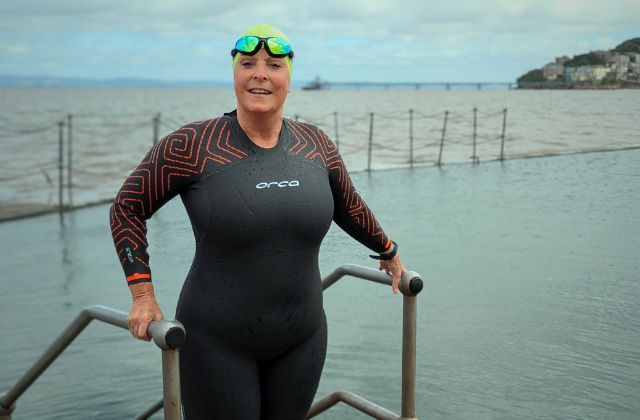
2/ One piece Openwater Vitalis TRN women’s wetsuit
Best all-round swimming wetsuit
Specifications
- Reasonable price point
- For daily use
- High flexibility shoulders
- Laser cut neckline
- Smoothskin coating
Reasons to buy: Comfortable, flexible, inclusive sizing for taller or shorter swimmers, easy to get on
Reasons to avoid: Tricky to get the right fit at the higher end of the size range
Orca is one of our favourite open-water swimming brands, with a great range of products designed to enable people to enjoy the ocean. What makes its Vitalis wetsuit so popular?
Made of super-soft Yamamoto neoprene, the Vitalis is very flexible. This makes it easy to get on, and very comfortable to wear. The shoulder movement is fantastic – after a few strokes, you almost forget you’re wearing a wetsuit at all.
While it feels nuts that a small woman who normally wears a UK 10 (US 6) is a ‘Medium’, we appreciate that Orca has improved its sizing to include swimmers in bigger bodies. But our plus-sized testers did struggle a bit with the fit – read their review here.
For a year-round all-rounder, though, you can’t beat the Vitalis.
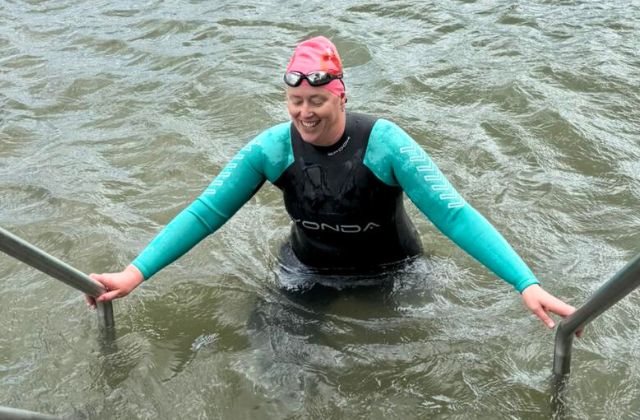
3/ Yonda Spook Wetsuit for women
Best entry-level outdoor swimming wetsuit
Specifications
- Reasonable price point
- Bright sleeves for visibility
- Flexibility
- Suppleness, fit and comfort
- No aching arms or shoulders
- Enables breaststroke
- Performance tear-resistance material
- Taped seams for extra strength
Reasons to buy: Comfortable, flexible, very inclusive sizing range, bright arms for visibility, neutral buoyancy, Facetime fitting help
Reasons to avoid: Not very technical
Yonda’s entry-level wetsuit is perfect if you’re just starting out with outdoor swimming. Its 1.5-3mm neoprene is best suited for temperate waters – late spring to early autumn.
With good flexibility, it’s comfortable for swimming front crawl. It has hip flexibility for swimming breaststroke too. And, unlike other wetsuits, it doesn’t have buoyancy panels in the thighs, which makes it even more suited to breaststroke.
We love Yonda’s inclusive sizing range. The wetsuit fits beautifully and isn’t at all restrictive.
It’s worth noting that the Spook lacks the refinement of other wetsuits, meaning it won’t enhance your performance like some of the technical suits.

4/ Lomo Nuotare Ladies Swimming Wetsuit
Best multisport wetsuit
Specifications
- Double lined Super Stretchy neoprene
- 3mm Torso panels for warmth
- 2mm Waist, legs and arms for warmth and flexibility
- Seam free underarm area for improved comfort and flexibility
- YKK zipper with pull cord
- Internal zip flap to reduce water flushing and increase comfort
- Flatlock stitching throughout
Reasons to buy: Comfortable, flexible, very inclusive sizing range, super stretchy, neutral buoyancy, durable
Reasons to avoid: No Smoothskin coating
Most swimming wetsuits come with a smoothskin neoprene. Designed to shave off seconds in races, smoothskin doesn’t absorb water making it easier to swim in. But it is also more fragile than normal neoprene.
That’s why we love Lomo’s Nuotare wetsuit. Made from a much more durable neoprene, it’s cut like a triathlon wetsuit, but it can withstand a lot more. This is great news if you love paddleboarding, kayaking, snorkelling and exploring rock pools as well as swimming.
The real Nuotare difference is how stretchy and flexible it is. Fitting like a second skin, you can move without restriction. It is the stretchiest, most comfortable wetsuit I have tried – you can literally do lunges in it.
I am also impressed by Lomo’s size range in this wetsuit. In a market that still serves plus-size swimmers so poorly, Lomo offers sizes UK8-32 and three height options – short, medium and tall.
As an open water swimming wetsuit, it loses marks for its lack of technical features. But, as a wetsuit for a casual dipper, breaststroke swimmer or someone who’s on and off their paddleboard, you can’t beat it.
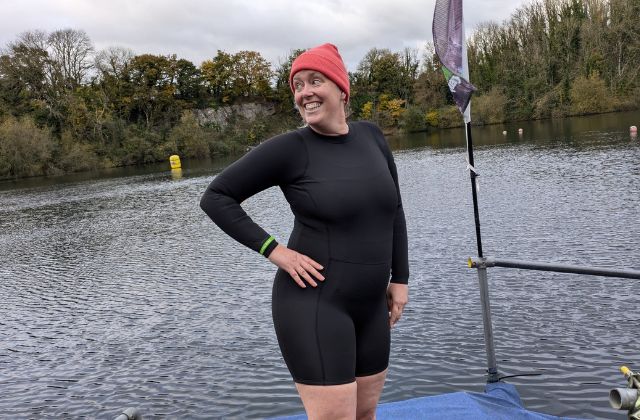
5/ Finisterre Women’s Nieuwland 2mm Yulex® Long Sleeve Shorty Wetsuit
Best shorty wetsuit for swimming
Specifications:
- 2mm YULEX® rubber
- Ergonomic panelling
- Long sleeves
- Leg length 2mm longer than other shortie suits
- Back zip for ease of entry and comfort when surfing
- Slight rise on collar for secure seal
Reasons to buy: Flexible, comfortable, great for breaststroke, sustainable, repair service available
Reasons to avoid: Cold legs
I absolutely love Finisterre’s range of Yulex wetsuits and swimsuits. Unlike neoprene or limestone neoprene, which has a toxic production process, Yulex is natural and sustainable.
Finisterre is a surf brand. So, while its wetsuits are fine for casual swimming, they don’t perform for distance or triathlon front crawl. However, if you’re a breaststroke swimmer looking for extra warmth and protection, we recommend this fab shorty.
With no neoprene on your legs, you won’t suffer from ‘floaty legs’ while swimming breaststroke. With 2mm Yulex elsewhere, it’s perfect for temperate and warmer water or as a step up from a swimsuit in cold water.
We found it comfortable, flexible and pretty warm for a cool springtime swim. It’s easy to get on and off and comes in a good range of sizes. A swimming kit favourite for year-round fun in the water.
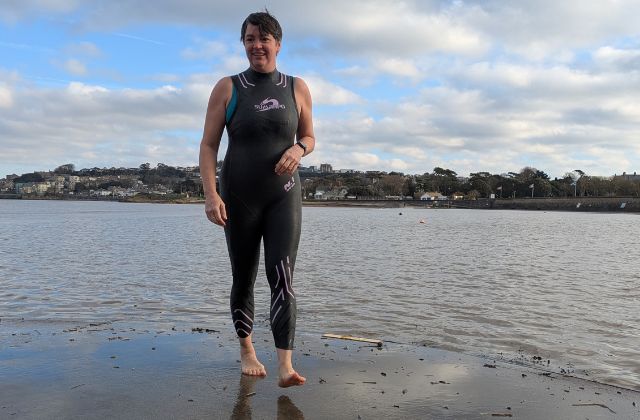
6/ Sumarpro Nova Women’s Sleeveless Eco Open Water Swimming Wetsuit
Best sleeveless performance swimming wetsuit
Specifications
- Yamamoto SCS neoprene
- Low modular tech
- Hypoallergenic materials
- Stable Trinity Support System
- Quick-release ankle panels
- Ergonomic-designed collar
- 2-year warranty
Reasons to buy: Soft, flexible neoprene, high neckline
Reasons to avoid: Only goes up to UK 14
A sleeveless wetsuit or ‘longjane’ is a great option for front crawl swimmers. You get the warmth in your torso, lift in your legs and full movement in your shoulders.
Sumarpro designs its wetsuits with racing in mind. The Yamamoto neoprene feels super-soft. The neck is high to reduce chafe. Sumarpro also uses something they call ‘Low Modulus Tech’ to help make your stroke more efficient.
We like the fit and cut of this wetsuit, and we love having our shoulders free. It doesn’t come in larger sizes, but with 5mm neoprene on the legs for extra buoyancy, it’s just as well – this wetsuit is best suited to lean triathletes and speedy swimmers who want a racing advantage.
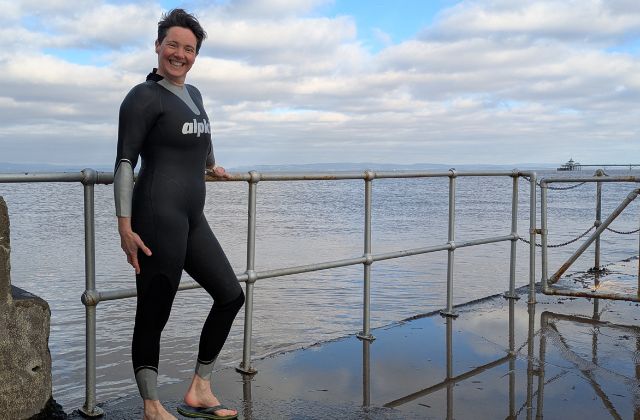
7/ Alpkit Silvertip Thermal Wetsuit for Women
Best thermal swimming wetsuit
Specifications
- 3mm neoprene
- Thermal lining
- Extra buoyancy
- Glideskin outer to drag and heat loss
Reasons to buy: Fleece-lined for warmth, smooth coating, flexible
Reasons to avoid: Limited sizing range
If you think a fleece-lined cold water swimming wetsuit sounds cosy, you’d be right. For those icy swims, nothing beats Alpkit’s thermal wetsuit.
Finding a decent thermal swimming wetsuit is about the balance between warmth and thickness. Alpkit has got this balance right. The cosy Silvertip is warm and buoyant but not too thick so we could swim comfortably.
It’s a wriggle to get on. But, once zipped into it, you’ve got thinner neoprene under the arms, around the shoulders and across the chest for flexibility. Add in the Glideskin neoprene outer which reduces drag, you have a decent performance wetsuit.
Add Alpkit’s bonnet, gloves and booties and you’re set for swimming in very cold water. And you never know – those accessories may have been made out of old Silvertips because they’re recyclable through Alpit’s partnership with Circular Flow.
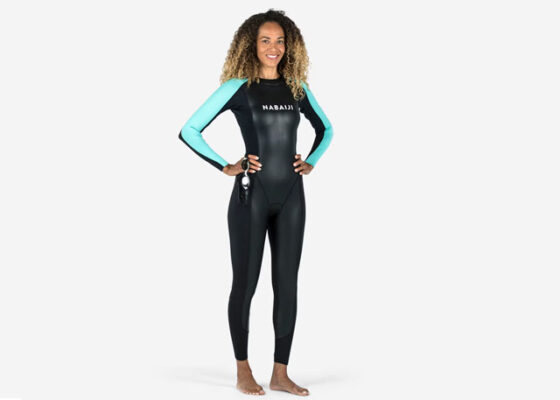
8/ Nabaiji open water swimming neoprene wetsuit for women
Best budget open-water swimming wetsuit
Specifications
- 2 mm glideskin neoprene on the chest and legs
- 8 mm standard neoprene on the arms
- Back zip
Reasons to buy: Low price point, flexible, comfortable, colourful arms for visibility
Reasons to avoid: No technical features, poor size range
It wasn’t that long ago that swimming wetsuits were bank-breaking luxuries. So, how do budget-friendly options like Decathlon’s home-brand wetsuits compare to the competition?
Pretty well, is the short answer. As you might expect, the Nabaiji suit doesn’t have the technical features of more expensive suits. But most outdoor swimmers don’t need a performance wetsuit.
Our tester swam breaststroke and a bit of front crawl in this wetsuit. She found it flexible and comfortable. We like the combination of stretchy neoprene on the shoulders, arms and hips with Glideskin panels down the front. This means freedom of movement in your arms and legs and reduced drag in the water.
While it’s comfortable, it lacks the refinement of its more expensive counterparts. However, if you want a casual swimming wetsuit that doesn’t break the bank, Nabaiji’s offering is ideal.
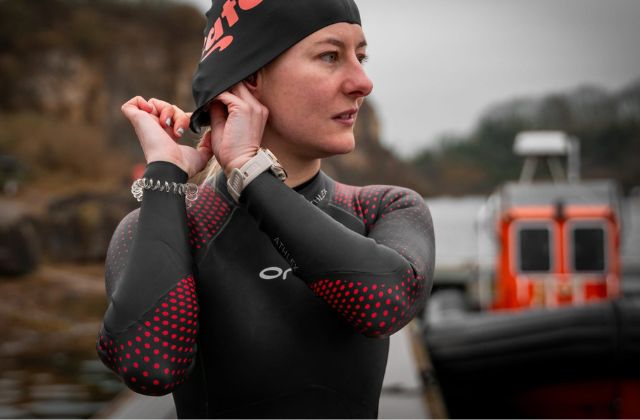
8/ Orca Athlex Float V2 Women Triathlon Wetsuit
Best cold water triathlon wetsuit
Specifications
- Yamamoto neoprene
- High buoyancy
- High elasticity
- Smoothskin surface
- Cut for female or male bodies
- Compressive inner lining
- Hydrolite technology for easy transition
Reasons to buy: Warm, comfortable, easy to get on, very buoyant
Reasons to avoid: Too good Velcro!
Alongside its open water range, Orca offers triathlon wetsuits. Made for racing, these wetsuits are highly technical with lots of performance-enhancing features.
Our tester is a petite, female triathlete who feels the cold. Orca recommended the Athlex Float for two reasons – one, it would support her body position in the water and two, it would keep her warmer.
We love the buoyancy and the difference it makes to our body position. We also love the warmth, which allows us to stretch the outdoor training season. However, there’s a trade-off – it takes more effort to push more buoyant arms under the water, and the shoulders are a bit less flexible than with very thin neoprene.
The wetsuit is super easy to pull on and fits like a hug. But we found that the Velcro was so strong it was hard to undo. Once undone, though, the wetsuit slips off easily allowing for quick transitions.
A super silky glide through the water means you’ll swim more streamlined and fast-paced. If that’s your aim, then the Athlex Float is a winner.
Buying guide: How to choose an outdoor swimming wetsuit
Before you buy your open water swimming wetsuit, it helps to know a couple of things. First of all, it’s a WETsuit so it doesn’t keep you dry. Instead, it keeps you warm by trapping a thin layer of water between your skin and the neoprene, which warms up to your body temperature. Secondly, swimming wetsuits have a water-repellent coating and general use wetsuits don’t. This means that water glides off them, making you glide through the water more easily.
With these two facts in mind when shopping for a swimming wetsuit, start by asking yourself three questions:
- What sort of swimming will I be doing?
- What temperature water will I be swimming in?
- Will I use my wetsuit for any other water sports?
Wetsuits for front crawl or breaststroke?
The types of outdoor swimming you might do are dipping, casual or leisure swimming, endurance or challenge swimming, racing or triathlon. Choose the main type for which you want your wetsuit – and think about the main stroke that you’ll be swimming.
- Dipping: No wetsuit or a shorty/neoprene swimsuit that’s easy and quick to get on and off
- Casual/leisure swimming: A shorty, multi sport or beginner wetsuit
- Endurance/challenge swimming: A technical swimming wetsuit with a Smoothskin coating and good shoulder support
- Racing/triathlon: A technical swimming wetsuit with Smoothskin, shoulder flexibility and buoyancy panels
- Front crawl: Look for good shoulder support and flexibility
- Breaststroke: Look for no added buoyancy in the legs and hip flexibility
Wetsuits for cold, temperature and warm water
Water temperature is a really important consideration for your wetsuit choice. In the UK, the sea temperature ranges from 5-17˚C depending on location and time of the year. But, elsewhere in the world, water temperature can vary enormously.
- >22˚C+: Don’t wear a wetsuit. Prioritise sun protection instead.
- 18-22˚C: You probably don’t need a wetsuit, but you could choose a thin (1mm-2mm) wetsuit for casual or leisure swimming
- 14-18˚C: Choose a 2/3mm wetsuit
- 10-14˚C: Choose a 3-5mm or thermal wetsuit
- 5-10˚C: Thermal wetsuit
- <5˚C: Choose something that’s quick and easy to get off when you’re cold
Wetsuits for multi sports
The problem with that lovely Smoothskin neoprene is that it’s much more fragile than normal neoprene. If you’re combining your swimming with another water sport, pick a multi-sport wetsuit that’s made of more robust material.
How should my wetsuit fit?
Fit is so important because your wetsuit will only work if it can trap that layer of water next to your skin. If it’s too loose, it will make you colder than if you had no wetsuit on at all. If it’s too tight, you will be uncomfortable. Watch out for the following pinch points:
- Legs and arms: It doesn’t matter if your cuffs don’t come all the way down to your wrists/ankles. Just make sure they’re not uncomfortably tight.
- Crotch: Your wetsuit should fit into your crotch with no gap.
- Armpits: Your wetsuit should fit into your armpits with no gap
- Lumbar spine: Make sure your wetsuit is flush to your spine with no gap where your back curves in
- Neck: You need a comfortable fit at your neck – not too tight.
Try before you buy
Swimming in a wetsuit for the first time feels strange. The compression, especially around your chest and shoulders, can make you feel panicky. That’s why it’s super important to try it out before setting off on a long swim or taking part in a race.
Some wetsuit retailers have endless pools where you can try before you buy. I recommend doing this if you can. Another great option is to hire a wetsuit. Any kit hire expert will be able to advise you on which wetsuit to choose and you get to try it before committing.
How to choose a sustainable wetsuit
Unfortunately, neoprene is not only bad for the environment, but its production also seriously harms human health around the factories where it’s produced. Made from chloroprene rubber, it’s derived from carbon – that’s either oil or limestone. The production of both is incredibly hard on the environment. Plus, most neoprene is not recyclable.
The only truly sustainable wetsuit material is natural rubber Yulex. If you can, opt for Yulex wherever possible. However, there are very few swimming wetsuits made from Yulex. Another option is to buy second hand. Failing that, make sure you buy the right wetsuit that best suits your needs.
The post 9 of the best year-round women’s swimming wetsuits appeared first on Yachting World.

Latest News
For Sale! 2016 Sea Ray 350 Sundancer – $180,000
Reel Deal Yacht is pleased to feature a meticulously maintained 2016 Sea...
Creating the Finest Yacht Instruments in the World
A+T Instruments: Crafting the World’s Best Yacht Instruments In the world of...
Why Miami is the Best Place to Buy a Boat
Miami has long been regarded as the ultimate destination for yacht and...
What Are the Best Floating Docks? How to choose for stability, safety and style
For most boat owners, a private pontoon is the dream: instant access...
Best family yacht: The best yachts for sailing with the family
Toby Hodges takes a look at all the nominees and the winner...












Leave a comment